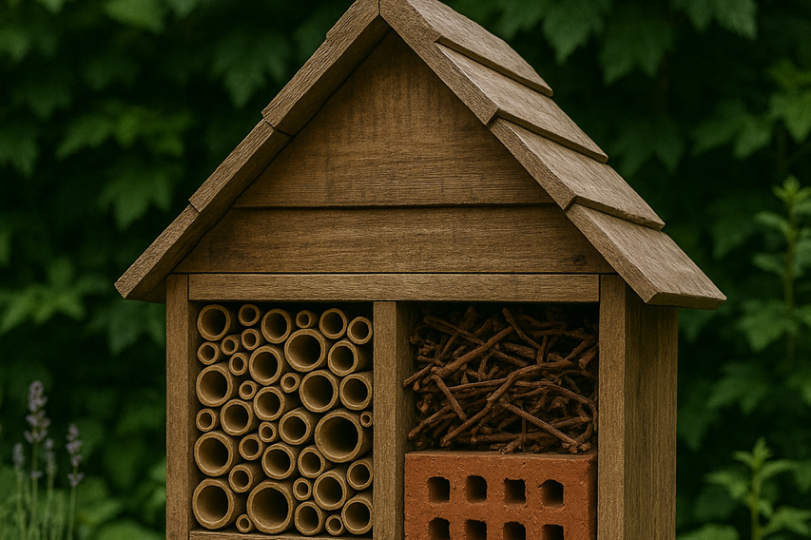
How to Make a Bug Box and Hedgehog Home in an Urban Garden

How to Make a Bug Box and Hedgehog Home in an Urban Garden Living in a new, energy-efficient home is a great starting point for reducing your environmental impact. At Aquilla Row in Brentwood, sustainability is built into the homes, and it’s also part of the lifestyle. The location, surrounded by mature woodland and green space, encourages residents to connect with nature, even in small and practical ways. If you're looking for simple projects to support biodiversity in your garden, bug boxes and hedgehog homes are two of the most effective additions you can make. Both are straightforward to build, affordable, and work well in urban or suburban environments like Warley. Let’s explore how to create them, and why they matter.
Urban green spaces play a valuable role in supporting wildlife. Even small gardens can become important habitats for insects and mammals. Bug boxes provide shelter for solitary bees, ladybirds, lacewings and other beneficial insects. These species help control pests and pollinate plants. Hedgehog homes offer a safe, dry space for hedgehogs to rest, hibernate or raise young, especially in areas where natural shelter may be limited due to fencing and landscaping. Encouraging both, adds ecological value to your outdoor space and supports the broader biodiversity in the area.
You don’t need specialist tools or expensive materials to make a functional and attractive bug hotel. In fact, repurposing materials you already have is one of the best ways to make the project more sustainable.
Materials You’ll Need
• Wooden box or crate (roughly 30cm x 30cm x 10cm)
• Range of natural materials: bamboo canes, pinecones, hollow plant stems, bark, straw, small logs with holes drilled in
• Chicken wire or mesh (optional, for securing contents)
• Hammer and nails or wood glue
• Waterproof roof or slate tile to keep rain off the top
Step-by-Step Instructions
• Choose your box: A wooden wine crate, drawer, or DIY-built frame from untreated wood will work well.
• Create compartments: Divide the box into sections using smaller pieces of wood or twigs.
• Fill each section with different materials: Bamboo or reed segments for solitary bees; Straw or bark for beetles and woodlice; Pinecones and dry leaves for ladybirds and lacewings
• Fix everything securely so it won’t fall out. You can use mesh or chicken wire across the front if needed.
• Add a roof to protect it from rain.
Place your bug box in a sheltered area, around one metre off the ground, ideally in a sunny spot that doesn’t get too windy.
Hedgehogs are becoming increasingly rare in the UK. Giving them a place to shelter can make a big difference, particularly in enclosed gardens where access to natural nesting sites may be limited.
Materials You’ll Need
• 1 sheet of untreated plywood (approx. 60cm x 60cm)
• Screws or nails
• Hinges (optional for roof access) • Small length of drainage pipe (for the entrance tunnel)
• Straw or dry leaves (for bedding)
• Drill or saw (for cutting access holes and assembly)
Step-by-Step Instructions
• Build a basic box: A hedgehog home should be around 40cm x 30cm x 20cm in size.
• Create an entrance tunnel: Use a piece of piping or build an extended corridor to help prevent predators from reaching inside.
• Drill ventilation holes: These are essential for airflow but should be small enough to keep the interior protected.
• Add bedding: Place dry leaves or straw inside. Avoid hay, as it can be too damp.
• Position carefully: Place the house in a quiet, shaded corner of your garden. It should be away from paths and ideally next to a hedge or fence line.
• Cover with logs or leaves to provide extra insulation and camouflage.
If you are wondering how to make your garden more wildlife-friendly, in addition to your bug box and hedgehog house, there are a few other ways to improve sustainability in your outdoor space:
• Plant pollinator-friendly flowers like lavender, foxglove and verbena
• Create log piles or leave a patch of your lawn un-mown
• Install a small water source like a shallow dish or wildlife pond
• Avoid chemical pesticides and fertilisers
• Leave gaps in fences to allow hedgehogs to move between gardens
Aquilla Row homes have been designed with sustainability at the centre. Each home comes with EPC A-rated energy efficiency, EV charging points, and pre-wiring for heat pumps. But sustainability is about the choice of technology, it’s about lifestyle too. With Thorndon Country Park, Warley Place Nature Reserve, and local woodlands nearby, residents are already surrounded by nature. Adding simple features like bug hotels and hedgehog houses brings that connection even closer to home. Gardens at Aquilla Row are landscaped and ready for use, giving new homeowners the perfect blank canvas to create their own green space with both aesthetics and biodiversity in mind.
So whether you’re a seasoned gardener or just getting started, adding a bug box or hedgehog home is a quick project that brings long-term benefits. It’s easy to do, inexpensive, and aligns perfectly with the values of modern, low-impact living. Living at Aquilla Row (https://www.struttandparker.com/properties/clive-road-1) gives you the opportunity to enjoy all the advantages of an energy-efficient, well-connected home, while still supporting local wildlife and making small contributions to a bigger picture.
For more information about available houses for sale in Brentwood, and how to arrange a viewing, get in touch with us today.
